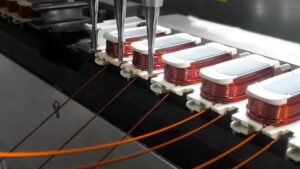LINEAR WINDING
Linear winding refers to a special process in which wire or thread is wound linearly around a spool, spindle or other cylindrical device. This technique is used in various applications, from the manufacture of electrical coils and transformers to the production of yarns and threads.
In linear winding, the wire or thread is wound in a straight line around the bobbin, with each turn closely following the previous one. The winding process can be done by hand or by automated winding machines, depending on the application and the precision required.
There are several factors that must be considered in linear winding to produce high quality windings. These include:
Tension control: The wire or filament should be wound at a consistent tension to ensure consistent winding density and quality. Too high a tension can damage the wire, while too low a tension can result in loosely wound turns.
Uniform speed: The speed at which the wire or thread is wound should be constant and uniform to ensure even distribution of turns.
Alignment: The wire or thread should be wound parallel to the spool or fixture to ensure correct alignment and good winding quality.
Tension control: The tension of the wound wire or thread should be monitored and controlled to ensure that it is firmly and securely attached to the spool.
Linear wound coils are used in a variety of applications including electric motors, transformers, sensors, coils for electronic circuits and in the textile industry for the production of yarns and threads. Precise and uniform winding is critical to ensure the desired electrical performance or quality of the end product.

